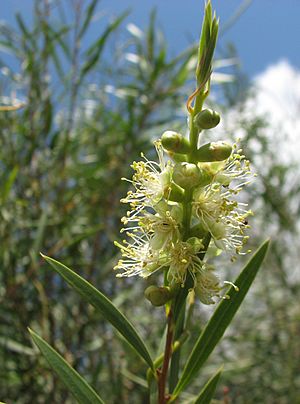Desert bottlebrush facts for kids
Quick facts for kids Desert bottlebrush |
|
|---|---|
 |
|
| M. faucicola in Geelong Botanic Gardens, Victoria, Australia | |
| Scientific classification | |
| Genus: |
Melaleuca
|
| Species: |
faucicola
|
| Synonyms | |
|
Callistemon pauciflorus R.D.Spencer & Lumley |
|
The Desert Bottlebrush, officially known as Melaleuca faucicola, is a special plant found in the Northern Territory of Australia. It's part of the myrtle family, just like eucalyptus trees. This plant is endemic to Australia, meaning it naturally grows only there. You can find it as a shrub or a small tree, usually hidden away in protected gorges within the mountain ranges of Central Australia, like the Petermann Ranges. It's famous for its unique flower spikes, which can be red, cream, or white.
Contents
What Does the Desert Bottlebrush Look Like?
The Melaleuca faucicola is a shrub that can grow up to 1.515 m (5 ft) tall. It has bark that is hard and cracked.
Leaves and How They Grow
Its leaves grow one after another along the stem, not in pairs. They are about 25–89 mm (1–4 in) long and 3.5–16 mm (0.1–0.6 in) wide. The leaves are flat and shaped like a narrow spear (lance-shaped). You can see a clear vein down the middle and many smaller veins branching off. They also have tiny oil glands that you might notice.
Flowers and Fruits
The flowers of the desert bottlebrush can be red, pink, cream, or white. They grow in spikes at the ends of branches, which keep growing even after the flowers bloom. You can also find flower spikes along the sides of the branches. Each spike is about 27 mm (1 in) wide and holds between 7 and 17 individual flowers.
The petals of each flower are small, about 2.5–4.4 mm (0.1–0.2 in) long. They fall off as the flower gets older. Inside each flower, there are many stamens (the parts that produce pollen), usually between 52 and 71. Some of these stamens are joined together in small groups.
This plant can flower at different times throughout the year, not just in one season. After the flowers, the plant produces woody fruits called capsules. These capsules are small, about 2.8–4.5 mm (0.1–0.2 in) long.
How the Desert Bottlebrush Got Its Name
The scientific name Melaleuca faucicola was given to this plant in 2006 by a scientist named Lyndley Craven. Before that, it was known by a different name, Callistemon pauciflorus.
The Meaning of faucicola
The name faucicola comes from two Latin words. Faux means "throat" or "gorge," and -cola means "dweller in." So, faucicola means "dweller in gorges." This name perfectly describes where this plant likes to live: in the protected, rocky gorges of Central Australia.
Where Does the Desert Bottlebrush Grow?
This type of melaleuca plant is found in several mountain ranges in the Northern Territory. These include the Central Ranges, MacDonnell Ranges, and Petermann Ranges. It prefers to grow close to waterholes in the sheltered sandstone gorges found in these areas.
Is the Desert Bottlebrush in Danger?
The Melaleuca faucicola is currently listed as "near threatened." This means that while it's not in immediate danger of disappearing, its numbers are getting low. It is important to protect its habitat to make sure it continues to thrive in the wild.

